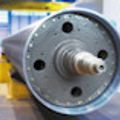Balancing rolls - balance and imbalance, isolating the problem
Jun 16, 2020
How exactly does speed equate with roll imbalance? The math is easy. The higher the machine speed, the greater the amount of vibration forces produced by the machine. Over time, these vibrations can excite the entire system with the resultant force snowballing out of control. With each revolution, the defective roll hammers at the framework of the papermachine, negatively affecting other components and resulting in worn journals, bearings, and covers.

Valmet roll shops grind, recover, balance and refurbish rolls
Complicating matters is the fact that older rolls, designed for slower speeds, are still used in modern, high-speed machines.
Vibration forces can never be eliminated, so what is the solution? Build machines with massive frameworks to withstand the punishment of constant vibration? No, that would be impractical, not to mention extremely expensive.
Balancing the roll
The solution is to balance the machine's rolls at every roll service check. This can lengthen the life of the machine's components by producing less force to impact the entire papermachine, thus improving machine speed, productivity and the quality of the sheet.
For the most part, papermakers are aware of the need for roll balancing, but many never follow through with regular roll service work. Some think rolls remain balanced forever. Untrue. It doesn't take much to change a roll's centerline. A change of 1/1000 of an inch is enough to disrupt the balance of a roll.
Roll balancing is defined as "the manipulation of the roll's center of gravity so that it falls along the axis around which it must revolve." Unbalance exists if the axis tends to rotate about the center of gravity with the journals tracing a circular orbit.

In simple terms, balancing a roll is generally accomplished by either adding or subtracting weight. Holes are drilled into the roll's ends, face, heads or shell in order to insert counterweights or remove weight in the form of metal shavings.
Isolating the problem
Half the battle against solving a roll balance problem is knowing where to look. It is never easy to isolate a trouble spot on a machine equipped with 40+ rolls. The source can be any of over 200 different contributing elements.
For clues, roll specialists use characteristics of the two main roll types: flexible and rigid.
A specialist knows that a flexible roll, which is used in higher, more critical speed machines, has a thin-wall construction. The roll's ability to flex makes it susceptible to roll imbalance along the face.
On the other hand, a short, rigid roll, such as a press roll, will not flex in the middle, so imbalance problems are more apt to come from either the roll's ends or adjacent machinery in the rotating system.
Depending on the type of roll, its role in the papermaking process and its specification for balance, roll specialists contend with three major roll balancing problems: static imbalance, dynamic imbalance and flexible roll imbalance.
Static imbalance

Dynamic imbalance
A roll that is statically balanced can still pose problems. If an eccentric center of gravity develops at one end of the roll, a moment, or dynamic unbalance exists. This can only be detected by speeding the roll up and watching for the characteristic oscillation associated with this problem.
Roll specialists can measure the force component of the imbalance at the ends of the roll. Balance standards are designed into the machine and may differ from position to position. Roll specialists should be contacted for specific recommendations.
To correct such a problem, counterweights are attached to both ends of the roll to produce a dynamic balance.
Flexible roll imbalance
Roll walls often vary in thickness along the face and circumference of the roll. Over long periods of high-speed operation, these heavy spots become slung from the center of the roll. This causes the roll to deform under its own weight, producing a condition called whip, or flexible roll imbalance.
Unbalance of this type is complex and requires the specialist to add counterweights at intermediate points along the face of the roll.
Reducing force induced failures and their resultant downtime can go a long way toward improving papermachine efficiency.
For more information and assistance with solving roll balancing problems, contact your Valmet representative or get in touch with a Valmet roll shop.